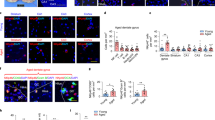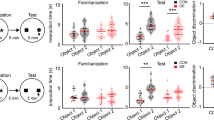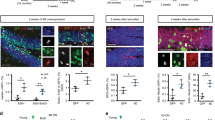Abstract
Neurogenesis is known to take place in the adult brain. This work identifies T lymphocytes and microglia as being important to the maintenance of hippocampal neurogenesis and spatial learning abilities in adulthood. Hippocampal neurogenesis induced by an enriched environment was associated with the recruitment of T cells and the activation of microglia. In immune-deficient mice, hippocampal neurogenesis was markedly impaired and could not be enhanced by environmental enrichment, but was restored and boosted by T cells recognizing a specific CNS antigen. CNS-specific T cells were also found to be required for spatial learning and memory and for the expression of brain-derived neurotrophic factor in the dentate gyrus, implying that a common immune-associated mechanism underlies different aspects of hippocampal plasticity and cell renewal in the adult brain.
This is a preview of subscription content, access via your institution
Access options
Subscribe to this journal
Receive 12 print issues and online access
$209.00 per year
only $17.42 per issue
Buy this article
- Purchase on Springer Link
- Instant access to full article PDF
Prices may be subject to local taxes which are calculated during checkout







Similar content being viewed by others
References
Cameron, H.A. & McKay, R.D. Adult neurogenesis produces a large pool of new granule cells in the dentate gyrus. J. Comp. Neurol. 435, 406–417 (2001).
Shors, T.J. et al. Neurogenesis in the adult is involved in the formation of trace memories. Nature 410, 372–376 (2001).
Shors, T.J., Townsend, D.A., Zhao, M., Kozorovitskiy, Y. & Gould, E. Neurogenesis may relate to some but not all types of hippocampal-dependent learning. Hippocampus 12, 578–584 (2002).
Moalem, G. et al. Autoimmune T cells protect neurons from secondary degeneration after central nervous system axotomy. Nat. Med. 5, 49–55 (1999).
Yoles, E. et al. Protective autoimmunity is a physiological response to CNS trauma. J. Neurosci. 21, 3740–3748 (2001).
Kipnis, J. et al. Neuroprotective autoimmunity: naturally occurring CD4+CD25+ regulatory T cells suppress the ability to withstand injury to the central nervous system. Proc. Natl. Acad. Sci. USA 99, 15620–15625 (2002).
Schwartz, M. & Kipnis, J. Protective autoimmunity: regulation and prospects for vaccination after brain and spinal cord injuries. Trends Mol. Med. 7, 252–258 (2001).
Butovsky, O., Talpalar, A.E., Ben-Yaakov, K. & Schwartz, M. Activation of microglia by aggregated beta-amyloid or lipopolysaccharide impairs MHC-II expression and renders them cytotoxic whereas IFN-gamma and IL-4 render them protective. Mol. Cell. Neurosci. 29, 381–393 (2005).
Shaked, I. et al. Protective autoimmunity: interferon-gamma enables microglia to remove glutamate without evoking inflammatory mediators. J. Neurochem. 92, 997–1009 (2005).
Butovsky, O., Hauben, E. & Schwartz, M. Morphological aspects of spinal cord autoimmune neuroprotection: colocalization of T cells with B7–2 (CD86) and prevention of cyst formation. FASEB J. 15, 1065–1067 (2001).
Butovsky, O. et al. Microglia activated by IL-4 or IFN-gamma differentially induce neurogenesis and oligodendrogenesis from adult stem/progenitor cells. Mol. Cell Neurosci. (2005).
Kempermann, G., Kuhn, H.G. & Gage, F.H. More hippocampal neurons in adult mice living in an enriched environment. Nature 386, 493–495 (1997).
van Praag, H., Christie, B.R., Sejnowski, T.J. & Gage, F.H. Running enhances neurogenesis, learning, and long-term potentiation in mice. Proc. Natl. Acad. Sci. USA 96, 13427–13431 (1999).
Monje, M.L., Toda, H. & Palmer, T.D. Inflammatory blockade restores adult hippocampal neurogenesis. Science 302, 1760–1765 (2003).
Trejo, J.L., Carro, E. & Torres-Aleman, I. Circulating insulin-like growth factor I mediates exercise-induced increases in the number of new neurons in the adult hippocampus. J. Neurosci. 21, 1628–1634 (2001).
Carro, E., Trejo, J.L., Busiguina, S. & Torres-Aleman, I. Circulating insulin-like growth factor I mediates the protective effects of physical exercise against brain insults of different etiology and anatomy. J. Neurosci. 21, 5678–5684 (2001).
Blunt, T. et al. Defective DNA-dependent protein kinase activity is linked to V(D)J recombination and DNA repair defects associated with the murine scid mutation. Cell 80, 813–823 (1995).
Cohen, H. et al. Maladaptation to mental stress mitigated by the adaptive immune system via depletion of naturally occurring regulatory CD4+CD25+ cells. J. Neurobiol. (in the press).
Olivares-Villagomez, D., Wang, Y. & Lafaille, J.J. Regulatory CD4(+) T cells expressing endogenous T cell receptor chains protect myelin basic protein-specific transgenic mice from spontaneous autoimmune encephalomyelitis. J. Exp. Med. 188, 1883–1894 (1998).
Ekdahl, C.T., Claasen, J.H., Bonde, S., Kokaia, Z. & Lindvall, O. Inflammation is detrimental for neurogenesis in adult brain. Proc. Natl. Acad. Sci. USA 100, 13632–13637 (2003).
Gould, E., Beylin, A., Tanapat, P., Reeves, A. & Shors, T.J. Learning enhances adult neurogenesis in the hippocampal formation. Nat. Neurosci. 2, 260–265 (1999).
Snyder, J.S., Hong, N.S., McDonald, R.J. & Wojtowicz, J.M. A role for adult neurogenesis in spatial long-term memory. Neuroscience 130, 843–852 (2005).
Martin, S.J., Grimwood, P.D. & Morris, R.G. Synaptic plasticity and memory: an evaluation of the hypothesis. Annu. Rev. Neurosci. 23, 649–711 (2000).
Kipnis, J., Cohen, H., Cardon, M., Ziv, Y. & Schwartz, M. T cell deficiency leads to cognitive dysfunction: implications for therapeutic vaccination for schizophrenia and other psychiatric conditions. Proc. Natl. Acad. Sci. USA 101, 8180–8185 (2004).
Moalem, G. et al. Production of neurotrophins by activated T cells: implications for neuroprotective autoimmunity. J. Autoimmun. 15, 331–345 (2000).
Mizuno, M., Yamada, K., Olariu, A., Nawa, H. & Nabeshima, T. Involvement of brain-derived neurotrophic factor in spatial memory formation and maintenance in a radial arm maze test in rats. J. Neurosci. 20, 7116–7121 (2000).
Scharfman, H. et al. Increased neurogenesis and the ectopic granule cells after intrahippocampal BDNF infusion in adult rats. Exp. Neurol. 192, 348–356 (2005).
Hauben, E. et al. Posttraumatic therapeutic vaccination with modified myelin self-antigen prevents complete paralysis while avoiding autoimmune disease. J. Clin. Invest. 108, 591–599 (2001).
Schwartz, M. & Kipnis, J. Autoimmunity on alert: naturally occurring regulatory CD4(+)CD25(+) T cells as part of the evolutionary compromise between a 'need' and a 'risk'. Trends Immunol. 23, 530–534 (2002).
Chun, J.J., Schatz, D.G., Oettinger, M.A., Jaenisch, R. & Baltimore, D. The recombination activating gene-1 (RAG-1) transcript is present in the murine central nervous system. Cell 64, 189–200 (1991).
Engelhardt, B. & Ransohoff, R.M. The ins and outs of T-lymphocyte trafficking to the CNS: anatomical sites and molecular mechanisms. Trends Immunol. 26, 485–495 (2005).
Hickey, W.F., Hsu, B.L. & Kimura, H. T-lymphocyte entry into the central nervous system. J. Neurosci. Res. 28, 254–260 (1991).
Muhallab, S. et al. Differential expression of neurotrophic factors and inflammatory cytokines by myelin basic protein-specific and other recruited T cells infiltrating the central nervous system during experimental autoimmune encephalomyelitis. Scand. J. Immunol. 55, 264–273 (2002).
Kerschensteiner, M. et al. Activated human T cells, B cells, and monocytes produce brain-derived neurotrophic factor in vitro and in inflammatory brain lesions: a neuroprotective role of inflammation? J. Exp. Med. 189, 865–870 (1999).
Alvarez-Buylla, A. & Lim, D.A. For the long run: maintaining germinal niches in the adult brain. Neuron 41, 683–686 (2004).
Pull, S.L., Doherty, J.M., Mills, J.C., Gordon, J.I. & Stappenbeck, T.S. Activated macrophages are an adaptive element of the colonic epithelial progenitor niche necessary for regenerative responses to injury. Proc. Natl. Acad. Sci. USA 102, 99–104 (2005).
Emsley, J.G., Mitchell, B.D., Kempermann, G. & Macklis, J.D. Adult neurogenesis and repair of the adult CNS with neural progenitors, precursors, and stem cells. Prog. Neurobiol. 75, 321–341 (2005).
Pluchino, S. et al. Injection of adult neurospheres induces recovery in a chronic model of multiple sclerosis. Nature 422, 688–694 (2003).
Aarum, J., Sandberg, K., Haeberlein, S.L. & Persson, M.A. Migration and differentiation of neural precursor cells can be directed by microglia. Proc. Natl. Acad. Sci. USA 100, 15983–15988 (2003).
Nimmerjahn, A., Kirchhoff, F. & Helmchen, F. Resting microglial cells are highly dynamic surveillants of brain parenchyma in vivo. Science 308, 1314–1318 (2005).
Ehninger, D. & Kempermann, G. Regional effects of wheel running and environmental enrichment on cell genesis and microglia proliferation in the adult murine neocortex. Cereb. Cortex 13, 845–851 (2003).
Mirescu, C., Peters, J.D. & Gould, E. Early life experience alters response of adult neurogenesis to stress. Nat. Neurosci. 7, 841–846 (2004).
Gaillard, R.C., Daneva, T., Hadid, R., Muller, K. & Spinedi, E. The hypothalamo-pituitary-adrenal axis of athymic Swiss nude mice. The implications of T lymphocytes in the ACTH release from immune cells. Ann. NY Acad. Sci. 840, 480–490 (1998).
Boulanger, L.M. & Shatz, C.J. Immune signalling in neural development, synaptic plasticity and disease. Nat. Rev. Neurosci. 5, 521–531 (2004).
Wekerle, H. Planting and pruning in the brain: MHC antigens involved in synaptic plasticity? Proc. Natl. Acad. Sci. USA 102, 3–4 (2005).
Linton, P.J. & Dorshkind, K. Age-related changes in lymphocyte development and function. Nat. Immunol. 5, 133–139 (2004).
Diesing, T.S., Swindells, S., Gelbard, H. & Gendelman, H.E. HIV-1-associated dementia: a basic science and clinical perspective. AIDS Read. 12, 358–368 (2002).
Brown, J. et al. Enriched environment and physical activity stimulate hippocampal but not olfactory bulb neurogenesis. Eur. J. Neurosci. 17, 2042–2046 (2003).
Acknowledgements
We thank S.R. Smith for editing the manuscript, A. Shapira for animal maintenance, H. Avital for graphics and O. Tchernichovsky and Y. Edelshtein for technical assistance. M.S. is the incumbent of the Maurice and Ilse Katz Professorial Chair in Neuroimmunology. This work was supported by Proneuron Biotechnologies, Weizmann Science Park, Ness-Ziona, Israel.
Author information
Authors and Affiliations
Corresponding authors
Ethics declarations
Competing interests
The authors declare no competing financial interests.
Supplementary information
Supplementary Fig. 1
Enriched environmental housing, consisting of a specially designed cage (150 × 60 × 60 cm) containing a variety of objects, toys, a set of tunnels, and running wheels. (PDF 1956 kb)
Supplementary Fig. 2
Analyses of T-cell populations in SCID mice before and after splenocyte replenishment. (PDF 188 kb)
Rights and permissions
About this article
Cite this article
Ziv, Y., Ron, N., Butovsky, O. et al. Immune cells contribute to the maintenance of neurogenesis and spatial learning abilities in adulthood. Nat Neurosci 9, 268–275 (2006). https://doi.org/10.1038/nn1629
Received:
Accepted:
Published:
Issue Date:
DOI: https://doi.org/10.1038/nn1629
This article is cited by
-
Role of meningeal immunity in brain function and protection against pathogens
Journal of Inflammation (2024)
-
iAstrocytes do not restrain T cell proliferation in vitro
BMC Neuroscience (2023)
-
Current views on meningeal lymphatics and immunity in aging and Alzheimer’s disease
Molecular Neurodegeneration (2023)
-
In conversation with Michal Schwartz
Nature Neuroscience (2023)
-
Type 2 immunity in the brain and brain borders
Cellular & Molecular Immunology (2023)



